InfraGard, a program run by the U.S. Federal Bureau of Investigation (FBI) to build cyber and physical threat information sharing partnerships with the private sector, this week saw its database of contact information on more than 80,000 members go up for sale on an English-language cybercrime forum. Meanwhile, the hackers responsible are communicating directly with members through the InfraGard portal online — using a new account under the assumed identity of a financial industry CEO that was vetted by the FBI itself.

On Dec. 10, 2022, the relatively new cybercrime forum Breached featured a bombshell new sales thread: The user database for InfraGard, including names and contact information for tens of thousands of InfraGard members.
The FBI’s InfraGard program is supposed to be a vetted Who’s Who of key people in private sector roles involving both cyber and physical security at companies that manage most of the nation’s critical infrastructures — including drinking water and power utilities, communications and financial services firms, transportation and manufacturing companies, healthcare providers, and nuclear energy firms.
“InfraGard connects critical infrastructure owners, operators, and stakeholders with the FBI to provide education, networking, and information-sharing on security threats and risks,” the FBI’s InfraGard fact sheet reads.
In response to information shared by KrebsOnSecurity, the FBI said it is aware of a potential false account associated with the InfraGard Portal and that it is actively looking into the matter.
“This is an ongoing situation, and we are not able to provide any additional information at this time,” the FBI said in a written statement.
KrebsOnSecurity contacted the seller of the InfraGard database, a Breached forum member who uses the handle “USDoD” and whose avatar is the seal of the U.S. Department of Defense.
USDoD said they gained access to the FBI’s InfraGard system by applying for a new account using the name, Social Security Number, date of birth and other personal details of a chief executive officer at a company that was highly likely to be granted InfraGard membership.
The CEO in question — currently the head of a major U.S. financial corporation that has a direct impact on the creditworthiness of most Americans — told KrebsOnSecurity they were never contacted by the FBI seeking to vet an InfraGard application.
USDoD told KrebsOnSecurity their phony application was submitted in November in the CEO’s name, and that the application included a contact email address that they controlled — but also the CEO’s real mobile phone number.
“When you register they said that to be approved can take at least three months,” USDoD said. “I wasn’t expected to be approve[d].”
 But USDoD said that in early December, their email address in the name of the CEO received a reply saying the application had been approved (see redacted screenshot to the right). While the FBI’s InfraGard system requires multi-factor authentication by default, users can choose between receiving a one-time code via SMS or email.
But USDoD said that in early December, their email address in the name of the CEO received a reply saying the application had been approved (see redacted screenshot to the right). While the FBI’s InfraGard system requires multi-factor authentication by default, users can choose between receiving a one-time code via SMS or email.
“If it was only the phone I will be in [a] bad situation,” USDoD said. “Because I used the person[‘s] phone that I’m impersonating.”
USDoD said the InfraGard user data was made easily available via an Application Programming Interface (API) that is built into several key components of the website that help InfraGard members connect and communicate with each other.
USDoD said after their InfraGard membership was approved, they asked a friend to code a script in Python to query that API and retrieve all available InfraGard user data.
“InfraGard is a social media intelligence hub for high profile persons,” USDoD said. “They even got [a] forum to discuss things.”
To prove they still had access to InfraGard as of publication time Tuesday evening, USDoD sent a direct note through InfraGard’s messaging system to an InfraGard member whose personal details were initially published as a teaser on the database sales thread.
That InfraGard member, who is head of security at a major U.S. technology firm, confirmed receipt of USDoD’s message but asked to remain anonymous for this story.
USDoD acknowledged that their $50,000 asking price for the InfraGard database may be a tad high, given that it is a fairly basic list of people who are already very security-conscious. Also, only about half of the user accounts contain an email address, and most of the other database fields — like Social Security Number and Date of Birth — are completely empty.
“I don’t think someone will pay that price, but I have to [price it] a bit higher to [negotiate] the price that I want,” they explained.
While the data exposed by the infiltration at InfraGard may be minimal, the user data might not have been the true end game for the intruders.
USDoD said they were hoping the imposter account would last long enough for them to finish sending direct messages as the CEO to other executives using the InfraGuard messaging portal. USDoD shared the following redacted screenshot from what they claimed was one such message, although they provided no additional context about it.
USDoD said in their sales thread that the guarantor for the transaction would be Pompompurin, the administrator of the cybercrime forum Breached. By purchasing the database through the forum administrator’s escrow service, would-be buyers can theoretically avoid getting ripped off and ensure the transaction will be consummated to the satisfaction of both parties before money exchanges hands.
Pompompurin has been a thorn in the side of the FBI for years. Their Breached forum is widely considered to be the second incarnation of RaidForums, a remarkably similar English-language cybercrime forum shuttered by the U.S. Department of Justice in April. Prior to its infiltration by the FBI, RaidForums sold access to more than 10 billion consumer records stolen in some of the world’s largest data breaches.
In November 2021, KrebsOnSecurity detailed how Pompompurin abused a vulnerability in an FBI online portal designed to share information with state and local law enforcement authorities, and how that access was used to blast out thousands of hoax email messages — all sent from an FBI email and Internet address.
Update, 10:58 p.m. ET: Updated the story after hearing from the financial company CEO whose identity was used to fool the FBI into approving an InfraGard membership. That CEO said they were never contacted by the FBI.
Update, 11:15 p.m. ET: The FBI just confirmed that it is aware of a potential false account associated with the InfraGard portal. The story now includes their full statement.
This is a developing story. Updates will be noted here with timestamps.
Ransomware groups are constantly devising new methods for infecting victims and convincing them to pay up, but a couple of strategies tested recently seem especially devious. The first centers on targeting healthcare organizations that offer consultations over the Internet and sending them booby-trapped medical records for the “patient.” The other involves carefully editing email inboxes of public company executives to make it appear that some were involved in insider trading.

Alex Holden is founder of Hold Security, a Milwaukee-based cybersecurity firm. Holden’s team gained visibility into discussions among members of two different ransom groups: CLOP (a.k.a. “Cl0p” a.k.a. “TA505“), and a newer ransom group known as Venus.
Last month, the U.S. Department of Health and Human Services (HHS) warned that Venus ransomware attacks were targeting a number of U.S. healthcare organizations. First spotted in mid-August 2022, Venus is known for hacking into victims’ publicly-exposed Remote Desktop services to encrypt Windows devices.
Holden said the internal discussions among the Venus group members indicate this gang has no problem gaining access to victim organizations.
“The Venus group has problems getting paid,” Holden said. “They are targeting a lot of U.S. companies, but nobody wants to pay them.”
Which might explain why their latest scheme centers on trying to frame executives at public companies for insider trading charges. Venus indicated it recently had success with a method that involves carefully editing one or more email inbox files at a victim firm — to insert messages discussing plans to trade large volumes of the company’s stock based on non-public information.
“We imitate correspondence of the [CEO] with a certain insider who shares financial reports of his companies through which your victim allegedly trades in the stock market, which naturally is a criminal offense and — according to US federal laws [includes the possibility of up to] 20 years in prison,” one Venus member wrote to an underling.
“You need to create this file and inject into the machine(s) like this so that metadata would say that they were created on his computer,” they continued. “One of my clients did it, I don’t know how. In addition to pst, you need to decompose several files into different places, so that metadata says the files are native from a certain date and time rather than created yesterday on an unknown machine.”
Holden said it’s not easy to plant emails into an inbox, but it can be done with Microsoft Outlook .pst files, which the attackers may also have access to if they’d already compromised a victim network.
“It’s not going to be forensically solid, but that’s not what they care about,” he said. “It still has the potential to be a huge scandal — at least for a while — when a victim is being threatened with the publication or release of these records.”
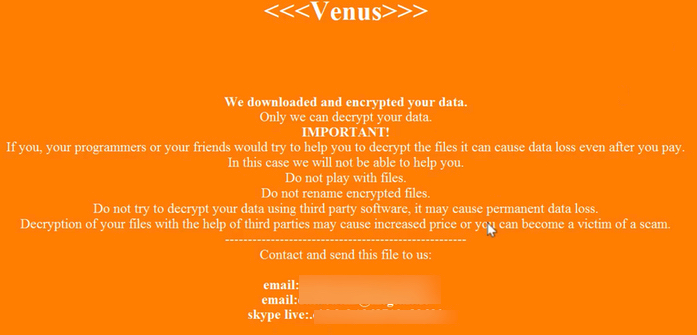
The Venus ransom group’s extortion note. Image: Tripwire.com
Holden said the CLOP ransomware gang has a different problem of late: Not enough victims. The intercepted CLOP communication seen by KrebsOnSecurity shows the group bragged about twice having success infiltrating new victims in the healthcare industry by sending them infected files disguised as ultrasound images or other medical documents for a patient seeking a remote consultation.
The CLOP members said one tried-and-true method of infecting healthcare providers involved gathering healthcare insurance and payment data to use in submitting requests for a remote consultation on a patient who has cirrhosis of the liver.
“Basically, they’re counting on doctors or nurses reviewing the patient’s chart and scans just before the appointment,” Holden said. “They initially discussed going in with cardiovascular issues, but decided cirrhosis or fibrosis of the liver would be more likely to be diagnosable remotely from existing test results and scans.”
While CLOP as a money making collective is a fairly young organization, security experts say CLOP members hail from a group of Threat Actors (TA) known as “TA505,” which MITRE’s ATT&CK database says is a financially motivated cybercrime group that has been active since at least 2014. “This group is known for frequently changing malware and driving global trends in criminal malware distribution,” MITRE assessed.
In April, 2021, KrebsOnSecurity detailed how CLOP helped pioneer another innovation aimed at pushing more victims into paying an extortion demand: Emailing the ransomware victim’s customers and partners directly and warning that their data would be leaked to the dark web unless they can convince the victim firm to pay up.
Security firm Tripwire points out that the HHS advisory on Venus says multiple threat actor groups are likely distributing the Venus ransomware. Tripwire’s tips for all organizations on avoiding ransomware attacks include:
While the above tips are important and useful, one critical area of ransomware preparedness overlooked by too many organizations is the need to develop — and then periodically rehearse — a plan for how everyone in the organization should respond in the event of a ransomware or data ransom incident. Drilling this breach response plan is key because it helps expose weaknesses in those plans that could be exploited by the intruders.
As noted in last year’s story Don’t Wanna Pay Ransom Gangs? Test Your Backups, experts say the biggest reason ransomware targets and/or their insurance providers still pay when they already have reliable backups of their systems and data is that nobody at the victim organization bothered to test in advance how long this data restoration process might take.
“Suddenly the victim notices they have a couple of petabytes of data to restore over the Internet, and they realize that even with their fast connections it’s going to take three months to download all these backup files,” said Fabian Wosar, chief technology officer at Emsisoft. “A lot of IT teams never actually make even a back-of-the-napkin calculation of how long it would take them to restore from a data rate perspective.”
A recent scoop by Reuters revealed that mobile apps for the U.S. Army and the Centers for Disease Control and Prevention (CDC) were integrating software that sends visitor data to a Russian company called Pushwoosh, which claims to be based in the United States. But that story omitted an important historical detail about Pushwoosh: In 2013, one of its developers admitted to authoring the Pincer Trojan, malware designed to surreptitiously intercept and forward text messages from Android mobile devices.
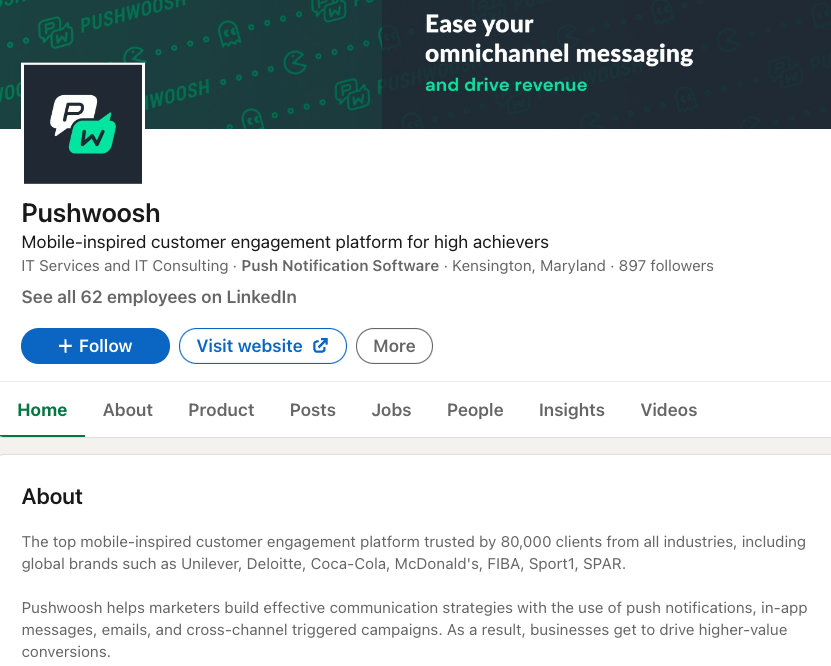
Pushwoosh says it is a U.S. based company that provides code for software developers to profile smartphone app users based on their online activity, allowing them to send tailor-made notifications. But a recent investigation by Reuters raised questions about the company’s real location and truthfulness.
The Army told Reuters it removed an app containing Pushwoosh in March, citing “security concerns.” The Army app was used by soldiers at one of the nation’s main combat training bases.
Reuters said the CDC likewise recently removed Pushwoosh code from its app over security concerns, after reporters informed the agency Pushwoosh was not based in the Washington D.C. area — as the company had represented — but was instead operated from Novosibirsk, Russia.
Pushwoosh’s software also was found in apps for “a wide array of international companies, influential nonprofits and government agencies from global consumer goods company Unilever and the Union of European Football Associations (UEFA) to the politically powerful U.S. gun lobby, the National Rifle Association (NRA), and Britain’s Labour Party.”
The company’s founder Max Konev told Reuters Pushwoosh “has no connection with the Russian government of any kind” and that it stores its data in the United States and Germany.
But Reuters found that while Pushwoosh’s social media and U.S. regulatory filings present it as a U.S. company based variously in California, Maryland and Washington, D.C., the company’s employees are located in Novosibirsk, Russia.
Reuters also learned that the company’s address in California does not exist, and that two LinkedIn accounts for Pushwoosh employees in Washington, D.C. were fake.
“Pushwoosh never mentioned it was Russian-based in eight annual filings in the U.S. state of Delaware, where it is registered, an omission which could violate state law,” Reuters reported.
Pushwoosh admitted the LinkedIn profiles were fake, but said they were created by a marketing firm to drum up business for the company — not misrepresent its location.
Pushwoosh told Reuters it used addresses in the Washington, D.C. area to “receive business correspondence” during the coronavirus pandemic. A review of the Pushwoosh founder’s online presence via Constella Intelligence shows his Pushwoosh email address was tied to a phone number in Washington, D.C. that was also connected to email addresses and account profiles for over a dozen other Pushwoosh employees.
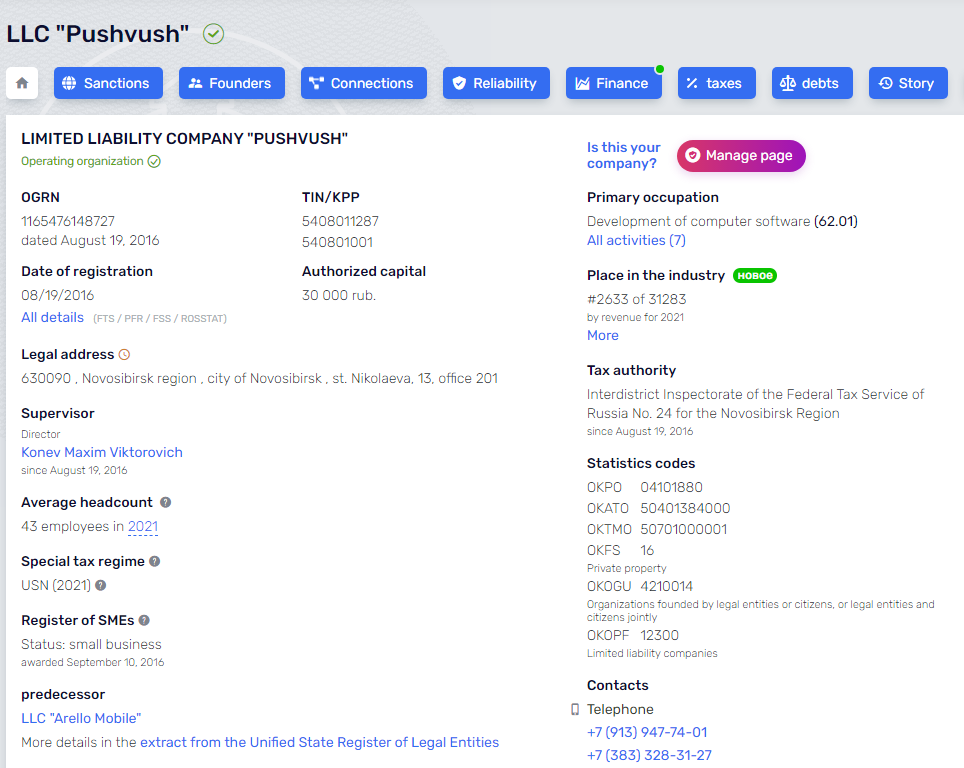
Pushwoosh was incorporated in Novosibirsk, Russia in 2016.
The dust-up over Pushwoosh came in part from data gathered by Zach Edwards, a security researcher who until recently worked for the Internet Safety Labs, a nonprofit organization that funds research into online threats.
Edwards said Pushwoosh began as Arello-Mobile, and for several years the two co-branded — appearing side by side at various technology expos. Around 2016, he said, the two companies both started using the Pushwoosh name.
A search on Pushwoosh’s code base shows that one of the company’s longtime developers is a 41-year-old from Novosibirsk named Yuri Shmakov. In 2013, KrebsOnSecurity interviewed Shmakov for the story, “Who Wrote the Pincer Android Trojan?” wherein Shmakov acknowledged writing the malware as a freelance project.
Shmakov told me that, based on the client’s specifications, he suspected it might ultimately be put to nefarious uses. Even so, he completed the job and signed his work by including his nickname in the app’s code.
“I was working on this app for some months, and I was hoping that it would be really helpful,” Shmakov wrote. “[The] idea of this app is that you can set it up as a spam filter…block some calls and SMS remotely, from a Web service. I hoped that this will be [some kind of] blacklist, with logging about blocked [messages/calls]. But of course, I understood that client [did] not really want this.”
Shmakov did not respond to requests for comment. His LinkedIn profile says he stopped working for Arello Mobile in 2016, and that he currently is employed full-time as the Android team leader at an online betting company.
In a blog post responding to the Reuters story, Pushwoosh said it is a privately held company incorporated under the state laws of Delaware, USA, and that Pushwoosh Inc. was never owned by any company registered in the Russian Federation.
“Pushwoosh Inc. used to outsource development parts of the product to the Russian company in Novosibirsk, mentioned in the article,” the company said. “However, in February 2022, Pushwoosh Inc. terminated the contract.”
However, Edwards noted that dozens of developer subdomains on Pushwoosh’s main domain still point to JSC Avantel, an Internet provider based in Novosibirsk, Russia.
Edwards said the U.S. Army’s app had a custom Pushwoosh configuration that did not appear on any other customer implementation.
“It had an extremely custom setup that existed nowhere else,” Edwards said. “Originally, it was an in-app Web browser, where it integrated a Pushwoosh javascript so that any time a user clicked on links, data went out to Pushwoosh and they could push back whatever they wanted through the in-app browser.”
An Army Times article published the day after the Reuters story ran said at least 1,000 people downloaded the app, which “delivered updates for troops at the National Training Center on Fort Irwin, Calif., a critical waypoint for deploying units to test their battlefield prowess before heading overseas.”
In April 2022, roughly 4,500 Army personnel converged on the National Training Center for a war games exercise on how to use lessons learned from Russia’s war against Ukraine to prepare for future fights against a major adversary such as Russia or China.
Edwards said despite Pushwoosh’s many prevarications, the company’s software doesn’t appear to have done anything untoward to its customers or users.
“Nothing they did has been seen to be malicious,” he said. “Other than completely lying about where they are, where their data is being hosted, and where they have infrastructure.”
Edwards also found Pushwoosh’s technology embedded in nearly two dozen mobile apps that were sold to cities and towns across Illinois as a way to help citizens access general information about their local communities and officials.
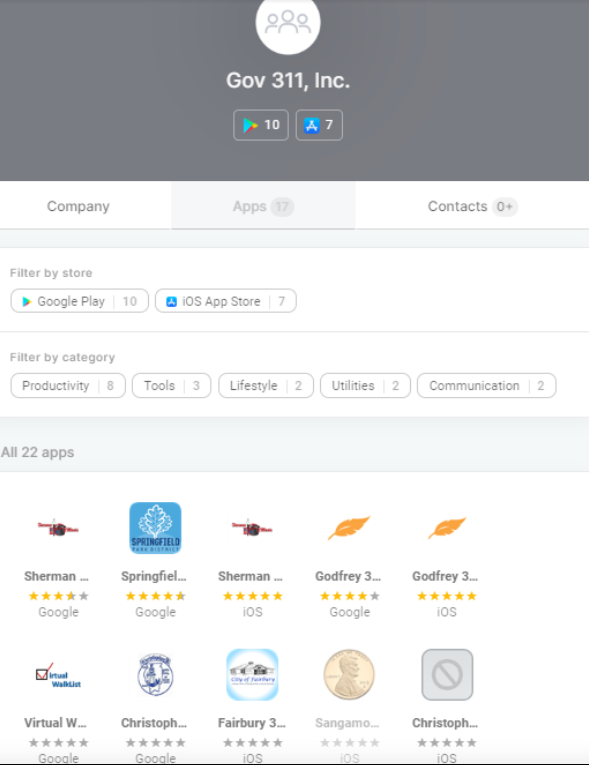 The Illinois apps that bundled Pushwoosh’s technology were produced by a company called Government 311, which is owned by Bill McCarty, the current director of the Springfield Office of Budget and Management. A 2014 story in The State Journal-Register said Gov 311’s pricing was based on population, and that the app would cost around $2,500 per year for a city with approximately 25,000 people.
The Illinois apps that bundled Pushwoosh’s technology were produced by a company called Government 311, which is owned by Bill McCarty, the current director of the Springfield Office of Budget and Management. A 2014 story in The State Journal-Register said Gov 311’s pricing was based on population, and that the app would cost around $2,500 per year for a city with approximately 25,000 people.
McCarty told KrebsOnSecurity that his company stopped using Pushwoosh “years ago,” and that it now relies on its own technology to provide push notifications through its 311 apps.
But Edwards found some of the 311 apps still try to phone home to Pushwoosh, such as the 311 app for Riverton, Ill.
“Riverton ceased being a client several years ago, which [is] probably why their app was never updated to change out Pushwoosh,” McCarty explained. “We are in the process of updating all client apps and a website refresh. As part of that, old unused apps like Riverton 311 will be deleted.”
Edwards said it’s far from clear how many other state and local government apps and Web sites rely on technology that sends user data to U.S. adversaries overseas. In July, Congress introduced an amended version of the Intelligence Authorization Act for 2023, which included a new section focusing on data drawn from online ad auctions that could be used to geolocate individuals or gain other information about them.
Business Insider reports that if this section makes it into the final version — which the Senate also has to pass — the Office for the Director of National Intelligence (ODNI) will have 60 days after the Act becomes law to produce a risk assessment. The assessment will look into “the counterintelligence risks of, and the exposure of intelligence community personnel to, tracking by foreign adversaries through advertising technology data,” the Act states.
Edwards says he’s hoping those changes pass, because what he found with Pushwoosh is likely just a drop in a bucket.
“I’m hoping that Congress acts on that,” he said. “If they were to put a requirement that there’s an annual audit of risks from foreign ad tech, that would at least force people to identify and document those connections.”
Vyacheslav “Tank” Penchukov, the accused 40-year-old Ukrainian leader of a prolific cybercriminal group that stole tens of millions of dollars from small to mid-sized businesses in the United States and Europe, has been arrested in Switzerland, according to multiple sources.

Wanted Ukrainian cybercrime suspect Vyacheslav “Tank” Penchukov (right) was arrested in Geneva, Switzerland. Tank was the day-to-day manager of a cybercriminal group that stole tens of millions of dollars from small to mid-sized businesses.
Penchukov was named in a 2014 indictment by the U.S. Department of Justice as a top figure in the JabberZeus Crew, a small but potent cybercriminal collective from Ukraine and Russia that attacked victim companies with a powerful, custom-made version of the Zeus banking trojan.
The U.S. Federal Bureau of Investigation (FBI) declined to comment for this story. But according to multiple sources, Penchukov was arrested in Geneva, Switzerland roughly three weeks ago as he was traveling to meet up with his wife there.
Penchukov is from Donetsk, a traditionally Russia-leaning region in Eastern Ukraine that was recently annexed by Russia. In his hometown, Penchukov was a well-known deejay (“DJ Slava Rich“) who enjoyed being seen riding around in his high-end BMWs and Porsches. More recently, Penchukov has been investing quite a bit in local businesses.
The JabberZeus crew’s name is derived from the malware they used, which was configured to send them a Jabber instant message each time a new victim entered a one-time password code into a phishing page mimicking their bank. The JabberZeus gang targeted mostly small to mid-sized businesses, and they were an early pioneer of so-called “man-in-the-browser” attacks, malware that can silently siphon any data that victims submit via a web-based form.
Once inside a victim company’s bank accounts, the crooks would modify the firm’s payroll to add dozens of “money mules,” people recruited through work-at-home schemes to handle bank transfers. The mules in turn would forward any stolen payroll deposits — minus their commissions — via wire transfer overseas.

Tank, a.k.a. “DJ Slava Rich,” seen here performing as a DJ in Ukraine in an undated photo from social media.
The JabberZeus malware was custom-made for the crime group by the alleged author of the Zeus trojan — Evgeniy Mikhailovich Bogachev, a top Russian cybercriminal with a $3 million bounty on his head from the FBI. Bogachev is accused of running the Gameover Zeus botnet, a massive crime machine of 500,000 to 1 million infected PCs that was used for large DDoS attacks and for spreading Cryptolocker — a peer-to-peer ransomware threat that was years ahead of its time.
Investigators knew Bogachev and JabberZeus were linked because for many years they were reading the private Jabber chats between and among members of the JabberZeus crew, and Bogachev’s monitored aliases were in semi-regular contact with the group about updates to the malware.
Gary Warner, director of research in computer forensics at the University of Alabama at Birmingham, noted in his blog from 2014 that Tank told co-conspirators in a JabberZeus chat on July 22, 2009 that his daughter, Miloslava, had been born and gave her birth weight.
“A search of Ukrainian birth records only showed one girl named Miloslava with that birth weight born on that day,” Warner wrote. This was enough to positively identify Tank as Penchukov, Warner said.
Ultimately, Penchukov’s political connections helped him evade prosecution by Ukrainian cybercrime investigators for many years. The late son of former Ukrainian President Victor Yanukovych (Victor Yanukovych Jr.) would serve as godfather to Tank’s daughter Miloslava. Through his connections to the Yanukovych family, Tank was able to establish contact with key insiders in top tiers of the Ukrainian government, including law enforcement.
Sources briefed on the investigation into Penchukov said that in 2010 — at a time when the Security Service of Ukraine (SBU) was preparing to serve search warrants on Tank and his crew — Tank received a tip that the SBU was coming to raid his home. That warning gave Tank ample time to destroy important evidence against the group, and to avoid being home when the raids happened. Those sources also said Tank used his contacts to have the investigation into his crew moved to a different unit that was headed by his corrupt SBU contact.
Writing for Technology Review, Patrick Howell O’Neil recounted how SBU agents in 2010 were trailing Tank around the city, watching closely as he moved between nightclubs and his apartment.
“In early October, the Ukrainian surveillance team said they’d lost him,” he wrote. “The Americans were unhappy, and a little surprised. But they were also resigned to what they saw as the realities of working in Ukraine. The country had a notorious corruption problem. The running joke was that it was easy to find the SBU’s anticorruption unit—just look for the parking lot full of BMWs.”
I first encountered Tank and the JabberZeus crew roughly 14 years ago as a reporter for The Washington Post, after a trusted source confided that he’d secretly gained access to the group’s private Jabber conversations.
From reading those discussions each day, it became clear Tank was nominally in charge of the Ukrainian crew, and that he spent much of his time overseeing the activities of the money mule recruiters — which were an integral part of their victim cashout scheme.
It was soon discovered that the phony corporate websites the money mule recruiters used to manage new hires had a security weakness that allowed anyone who signed up at the portal to view messages for every other user. A scraping tool was built to harvest these money mule recruitment messages, and at the height of the JabberZeus gang’s activity in 2010 that scraper was monitoring messages on close to a dozen different money mule recruitment sites, each managing hundreds of “employees.”
Each mule was given busy work or menial tasks for a few days or weeks prior to being asked to handle money transfers. I believe this was an effort to weed out unreliable money mules. After all, those who showed up late for work tended to cost the crooks a lot of money, as the victim’s bank would usually try to reverse any transfers that hadn’t already been withdrawn by the mules.
When it came time to transfer stolen funds, the recruiters would send a message through the fake company website saying something like: “Good morning [mule name here]. Our client — XYZ Corp. — is sending you some money today. Please visit your bank now and withdraw this payment in cash, and then wire the funds in equal payments — minus your commission — to these three individuals in Eastern Europe.”
Only, in every case the company mentioned as the “client” was in fact a small business whose payroll accounts they’d already hacked into.
So, each day for several years my morning routine went as follows: Make a pot of coffee; shuffle over to the computer and view the messages Tank and his co-conspirators had sent to their money mules over the previous 12-24 hours; look up the victim company names in Google; pick up the phone to warn each that they were in the process of being robbed by the Russian Cyber Mob.
My spiel on all of these calls was more or less the same: “You probably have no idea who I am, but here’s all my contact info and what I do. Your payroll accounts have been hacked, and you’re about to lose a great deal of money. You should contact your bank immediately and have them put a hold on any pending transfers before it’s too late. Feel free to call me back afterwards if you want more information about how I know all this, but for now please just call or visit your bank.”
In many instances, my call would come in just minutes or hours before an unauthorized payroll batch was processed by the victim company’s bank, and some of those notifications prevented what otherwise would have been enormous losses — often several times the amount of the organization’s normal weekly payroll. At some point I stopped counting how many tens of thousands of dollars those calls saved victims, but over several years it was probably in the millions.
Just as often, the victim company would suspect that I was somehow involved in the robbery, and soon after alerting them I would receive a call from an FBI agent or from a police officer in the victim’s hometown. Those were always interesting conversations.
Collectively, these notifications to victims led to dozens of stories over several years about small businesses battling their financial institutions to recover their losses. I never wrote about a single victim that wasn’t okay with my calling attention to their plight and to the sophistication of the threat facing other companies.
This incessant meddling on my part very much aggravated Tank, who on more than one occasion expressed mystification as to how I knew so much about their operations and victims. Here’s a snippet from one of their Jabber chats in 2009, after I’d written a story for The Washington Post about their efforts to steal $415,000 from the coffers of Bullitt County, Kentucky. In the chat below, “lucky12345” is the Zeus author Bogachev:
tank: Are you there?
tank: This is what they damn wrote about me.
tank: http://voices.washingtonpost.com/securityfix/2009/07/an_odyssey_of_fraud_part_ii.html#more
tank: I’ll take a quick look at history
tank: Originator: BULLITT COUNTY FISCAL Company: Bullitt County Fiscal Court
tank: Well, you got [it] from that cash-in.
lucky12345: From 200K?
tank: Well, they are not the right amounts and the cash out from that account was shitty.
tank: Levak was written there.
tank: Because now the entire USA knows about Zeus.
tank:
lucky12345: It’s fucked.
On Dec. 13, 2009, one of Tank’s top money mule recruiters — a crook who used the pseudonym “Jim Rogers” — told his boss something I hadn’t shared beyond a few trusted confidants at that point: That The Washington Post had eliminated my job in the process of merging the newspaper’s Web site (where I worked at the time) with the dead tree edition.
jim_rogers: There is a rumor that our favorite (Brian) didn’t get his contract extension at Washington Post. We are giddily awaiting confirmation
Good news expected exactly by the New Year! Besides us no one reads his column
tank: Mr. Fucking Brian Fucking Kerbs!
Another member of the JabberZeus crew — Ukrainian-born Maksim “Aqua” Yakubets — also is currently wanted by the FBI, which is offering a $5 million reward for information leading to his arrest and conviction.
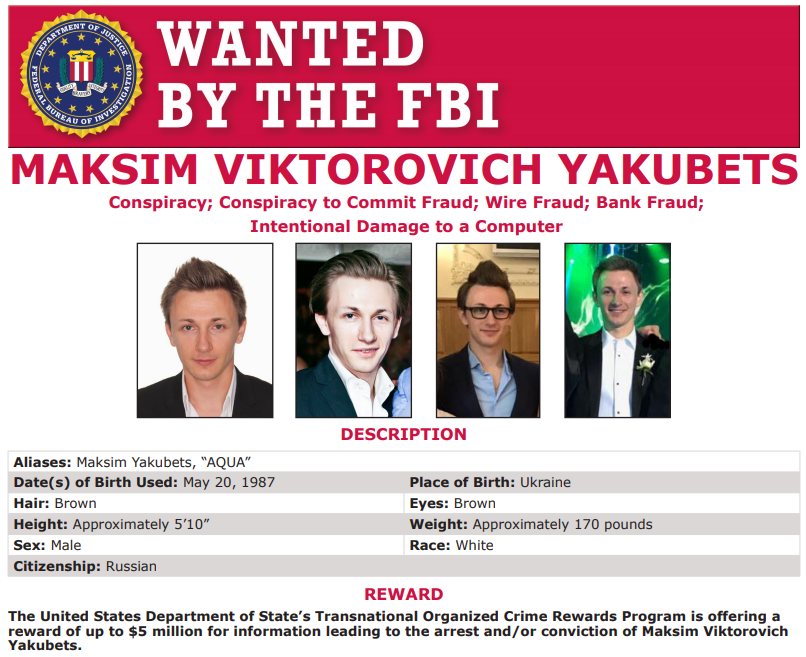
Alleged “Evil Corp” bigwig Maksim “Aqua” Yakubets. Image: FBI
Update, Nov. 16, 2022, 7:55 p.m. ET:: Multiple media outlets are reporting that Swiss authorities confirmed they arrested a Ukrainian national wanted on cybercrime charges. The arrest occurred in Geneva on Oct. 23, 2022. “The US authorities accuse the prosecuted person of extortion, bank fraud and identity theft, among other things,” reads a statement from the Swiss Federal Office of Justice (FOJ).
“During the hearing on 24 October, 2022, the person did not consent to his extradition to the USA via a simplified proceeding,” the FOJ continued. “After completion of the formal extradition procedure, the FOJ has decided to grant his extradition to the USA on 15 November, 2022. The decision of the FOJ may be appealed at the Swiss Criminal Federal Court, respectively at the Swiss Supreme Court.”
A nonprofit organization is suing the state of Massachusetts on behalf of thousands of low-income families who were collectively robbed of more than a $1 million in food assistance benefits by card skimming devices secretly installed at cash machines and grocery store checkout lanes across the state. Federal law bars states from replacing these benefits using federal funds, and a recent rash of skimming incidents nationwide has disproportionately affected those receiving food assistance via state-issued prepaid debit cards.

The Massachusetts SNAP benefits card looks more like a library card than a payment card.
On Nov. 4, The Massachusetts Law Reform Institute (MLRI) filed a class action lawsuit on behalf of low-income families whose Supplemental Nutrition and Assistance Program (SNAP) benefits were stolen from their accounts. The SNAP program serves over a million people in Massachusetts, and 41 million people nationally.
“Over the past few months, thieves have stolen over a million SNAP dollars from thousands of Massachusetts families – putting their nutrition and economic stability at risk,” the MLRI said in a statement on the lawsuit. “The criminals attach a skimming device on a POS (point of sale) terminal to capture the household’s account information and PIN. The criminals then use that information to make a fake card and steal the SNAP benefits.”
In announcing the lawsuit, the MRLI linked to a story KrebsOnSecurity published last month that examined how skimming thieves increasingly are targeting SNAP payment card holders nationwide. The story looked at how the vast majority of SNAP benefit cards issued by the states do not include the latest chip technology that makes it more difficult and expensive for thieves to clone them.
The story also highlighted how SNAP cardholders usually have little recourse to recover any stolen funds — even in unlikely cases where the victim has gathered mountains of proof to show state and federal officials that the fraudulent withdrawals were not theirs.
Deborah Harris is a staff attorney at the MLRI. Harris said the goal of the lawsuit is to force Massachusetts to reimburse SNAP skimming victims using state funds, and to convince The U.S. Department of Agriculture (USDA) — which funds the program that states draw from — to change its policies and allow states to replace stolen benefits with federal funds.
“Ultimately we think it’s the USDA that needs to step up and tell states they have a duty to restore the stolen benefits, and that USDA will cover the cost at least until there is better security in place, such as chip cards,” Harris told KrebsOnSecurity.
“The losses we’re talking about are relatively small in the scheme of total SNAP expenditures which are billions,” she said. “But if you are a family that can’t pay for food because you suddenly don’t have money in your account, it’s devastating for the family.”
The USDA has not said it will help states restore the stolen funds. But on Oct. 31, 2022, the agency released guidance (PDF) whose primary instructions were included in an appendix titled, Card Security Options Available to Households. Notably, the USDA did not mention the idea of shifting to chip-based SNAP benefits cards.

The recently issued USDA guidance.
“The guidance generally continues to make households responsible for preventing the theft of their benefits as well as for suffering the loss when benefits are stolen through no fault of the household,” Harris said. “Many of the recommendations are not practical for households who don’t have a smartphone to receive text messages and aren’t able to change their PIN after each transaction and keep track of the new PIN.”
Harris said three of the four recommendations are not currently available in Massachusetts, and they are very likely not currently available in other states. For example, she said, Massachusetts households do not have the option of freezing or locking their cards between transactions. Nor do they receive alerts about transactions. And they most certainly don’t have any way to block out-of-state transactions.
“Perhaps these are options that [card] processors and states could provide, but they are not available now as far as we know,” Harris said. “Most likely they would take time to implement.”
The Center for Law and Social Policy (CLASP) recently published Five Ways State Agencies Can Support EBT Users at Risk of Skimming. CLASP says while it is true states can’t use federal funds to replace benefits unless the loss was due to a “system error,” states could use their own funds.
“Doing so will ensure families don’t have to go without food, gas money, or their rent for the month,” CLASP wrote.
That would help address the symptoms of card skimming, but not a root cause. Hardly anyone is suggesting the obvious, which is to equip SNAP benefit cards with the same security technology afforded to practically everyone else participating in the U.S. banking system.
There are several reasons most state-issued SNAP benefit cards do not include chips. For starters, nobody says they have to. Also, it’s a fair bit more expensive to produce chip cards versus plain old magnetic stripe cards, and many state assistance programs are chronically under-funded. Finally, there is no vocal (or at least well-heeled) constituency advocating for change.
A copy of the class action complaint filed by the MLRI is available here.

A 25-year-old Finnish man has been charged with extorting a once popular and now-bankrupt online psychotherapy company and its patients. Finnish authorities rarely name suspects in an investigation, but they were willing to make an exception for Julius “Zeekill” Kivimaki, a notorious hacker who — at the tender age of 17 — had been convicted of more than 50,000 cybercrimes, including data breaches, payment fraud, operating botnets, and calling in bomb threats.
In late October 2022, Kivimaki was charged (and arrested in absentia, according to the Finns) with attempting to extort money from the Vastaamo Psychotherapy Center. On October 21, 2020, Vastaamo became the target of blackmail when a tormentor identified as “ransom_man” demanded payment of 40 bitcoins (~450,000 euros at the time) in return for a promise not to publish highly sensitive therapy session notes Vastaamo had exposed online.
In a series of posts over the ensuing days on a Finnish-language dark net discussion board, ransom_man said Vastaamo appeared unwilling to negotiate a payment, and that he would start publishing 100 patient profiles every 24 hours “to provide further incentive for the company to continue communicating with us.”
“We’re not asking for much, approximately 450,000 euros which is less than 10 euros per patient and only a small fraction of the around 20 million yearly revenues of this company,” ransom_man wrote.
When Vastaamo declined to pay, ransom_man shifted to extorting individual patients. According to Finnish police, some 22,000 victims reported extortion attempts targeting them personally, targeted emails that threatened to publish their therapy notes online unless paid a 500 euro ransom.
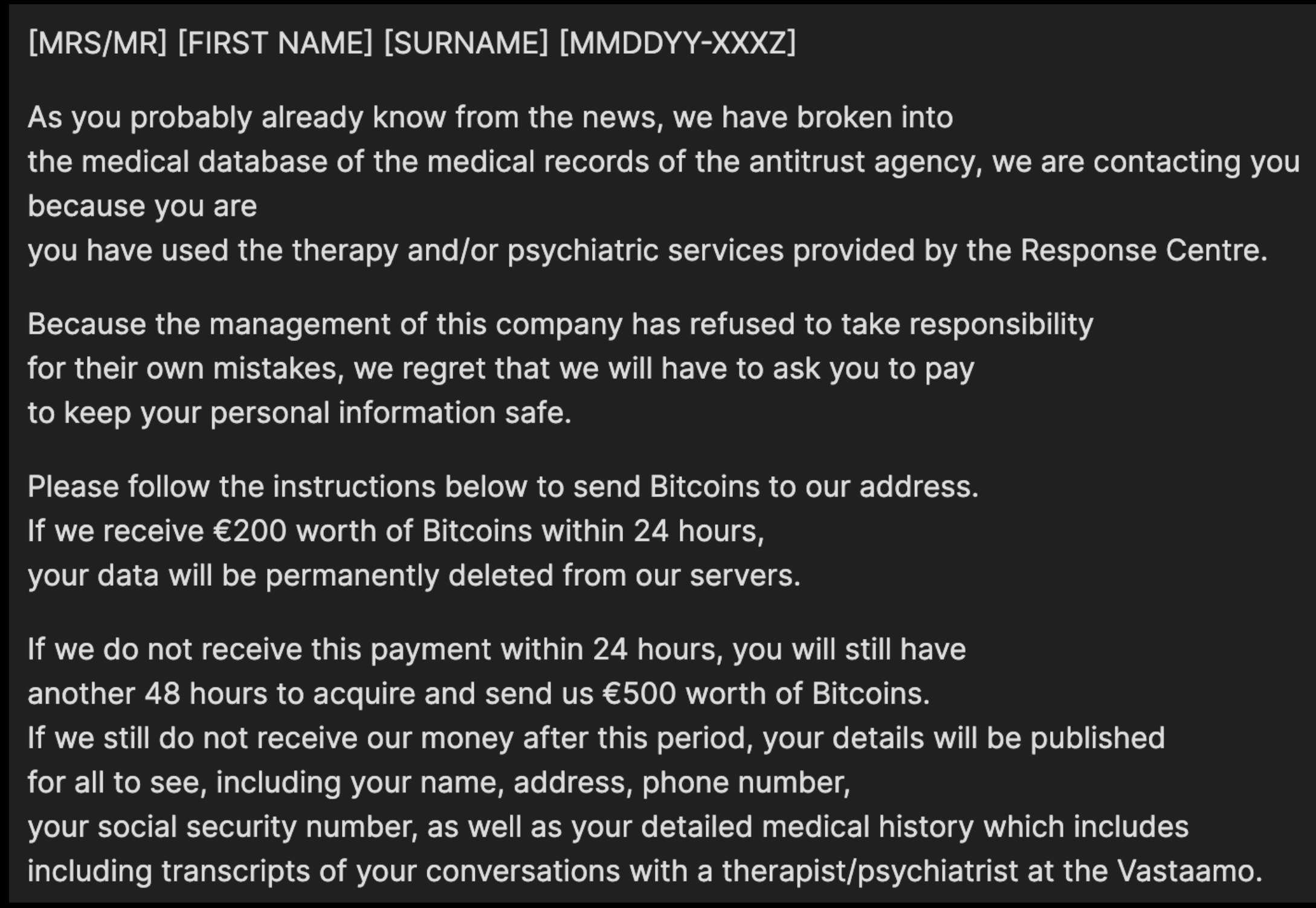
The extortion message targeted Vastaamo patients.
On Oct. 23, 2020, ransom_man uploaded to the dark web a large compressed file that included all of the stolen Vastaamo patient records. But investigators found the file also contained an entire copy of ransom_man’s home folder, a likely mistake that exposed a number of clues that they say point to Kivimaki.
Ransom_man quickly deleted the large file (accompanied by a “whoops” notation), but not before it had been downloaded a number of times. The entire archive has since been made into a searchable website on the Dark Web.
Among those who grabbed a copy of the database was Antti Kurittu, a team lead at Nixu Corporation and a former criminal investigator. In 2013, Kurittu worked on investigation involving Kivimaki’s use of the Zbot botnet, among other activities Kivimaki engaged in as a member of the hacker group Hack the Planet.
“It was a huge opsec [operational security] fail, because they had a lot of stuff in there — including the user’s private SSH folder, and a lot of known hosts that we could take a very good look at,” Kurittu told KrebsOnSecurity, declining to discuss specifics of the evidence investigators seized. “There were also other projects and databases.”
Kurittu said he and others he and others who were familiar with illegal activities attributed to Kivimäki couldn’t shake suspicion that the infamous cybercriminal was also behind the Vastaamo extortion.
“I couldn’t find anything that would link that data directly to one individual, but there were enough indicators in there that put the name in my head and I couldn’t shake it,” Kurittu said. “When they named him as the prime suspect I was not surprised.”
A handful of individually extorted victims paid a ransom, but when news broke that the entire Vastaamo database had been leaked online, the extortion threats no longer held their sting. However, someone would soon set up a site on the dark web where anyone could search this sensitive data.
Kivimaki stopped using his middle name Julius in favor of his given first name Aleksanteri when he moved abroad several years ago. A Twitter account by that name was verified by Kivimaki’s attorney as his, and through that account he denied being involved in the Vastaamo extortion.
“I believe [the Finnish authorities] brought this to the public in order to influence the decision-making of my old case from my teenage years, which was just processed in the Court of Appeal, both cases are investigated by the same persons,” Kivimaki tweeted on Oct. 28.
Kivimaki is appealing a 2020 district court decision sentencing him to “one year of conditional imprisonment for two counts of fraud committed as a young person, and one of gross fraud, interference with telecommunications as a young person, aggravated data breach as a young person and incitement to fraud as a young person,” according to the Finnish tabloid Ilta-Sanomat.
“Now in the Court of Appeal, the prosecutor is demanding a harsher punishment for the man, i.e. unconditional imprisonment,” reads the Ilta-Sanomat story. “The prosecutor notes in his complaint that the young man has been committing cybercrimes from Espoo since he was 15 years old, and the actions have had to be painstakingly investigated through international legal aid.”
As described in this Wired story last year, Vastaamo filled an urgent demand for psychological counseling, and it won accolades from Finnish health authorities and others for its services.
“Vastaamo was a private company, but it seemed to operate in the same spirit of tech-enabled ease and accessibility: You booked a therapist with a few clicks, wait times were tolerable, and Finland’s Social Insurance Institution reimbursed a big chunk of the session fee (provided you had a diagnosed mental disorder),” William Ralston wrote for Wired. “The company was run by Ville Tapio, a 39-year-old coder and entrepreneur with sharp eyebrows, slicked-back brown hair, and a heavy jawline. He’d cofounded the company with his parents. They pitched Vastaamo as a humble family-run enterprise committed to improving the mental health of all Finns.”
But for all the good it brought, the healthcare records management system that Vastaamo used relied on little more than a MySQL database that was left dangerously exposed to the web for 16 months, guarded by nothing more than an administrator account with a blank password.
The Finnish daily Iltalehti said Tapio was relieved of his duties as CEO of Vastaamo in October 2020, and that in September, prosecutors brought charges against Tapio for a data protection offense in connection with Vastaamo’s information leak.
“According to Vastaamo, the data breach in Vastaamo’s customer databases took place in November 2018,” Iltalehti reported last month. “According to Vastaamo, Tapio concealed information about the data breach for more than a year and a half.”
A 36-year-old Russian man recently identified by KrebsOnSecurity as the likely proprietor of the massive RSOCKS botnet has been arrested in Bulgaria at the request of U.S. authorities. At a court hearing in Bulgaria this month, the accused hacker requested and was granted extradition to the United States, reportedly telling the judge, “America is looking for me because I have enormous information and they need it.”

A copy of the passport for Denis Kloster, as posted to his Vkontakte page in 2019.
On June 22, KrebsOnSecurity published Meet the Administrators of the RSOCKS Proxy Botnet, which identified Denis Kloster, a.k.a. Denis Emelyantsev, as the apparent owner of RSOCKS, a collection of millions of hacked devices that were sold as “proxies” to cybercriminals looking for ways to route their malicious traffic through someone else’s computer.
A native of Omsk, Russia, Kloster came into focus after KrebsOnSecurity followed clues from the RSOCKS botnet master’s identity on the cybercrime forums to Kloster’s personal blog, which featured musings on the challenges of running a company that sells “security and anonymity services to customers around the world.” Kloster’s blog even included a group photo of RSOCKS employees.
“Thanks to you, we are now developing in the field of information security and anonymity!,” Kloster’s blog enthused. “We make products that are used by thousands of people around the world, and this is very cool! And this is just the beginning!!! We don’t just work together and we’re not just friends, we’re Family.”
The Bulgarian news outlet 24Chasa.bg reports that Kloster was arrested in June at a co-working space in the southwestern ski resort town of Bansko, and that the accused asked to be handed over to the American authorities.
“I have hired a lawyer there and I want you to send me as quickly as possible to clear these baseless charges,” Kloster reportedly told the Bulgarian court this week. “I am not a criminal and I will prove it in an American court.”
Launched in 2013, RSOCKS was shut down in June 2022 as part of an international investigation into the cybercrime service. According to the Justice Department, the RSOCKS botnet initially targeted Internet of Things (IoT) devices, including industrial control systems, time clocks, routers, audio/video streaming devices, and smart garage door openers; later in its existence, the RSOCKS botnet expanded into compromising additional types of devices, including Android devices and conventional computers, the DOJ said.
The Justice Department’s June 2022 statement about that takedown cited a search warrant from the U.S. Attorney’s Office for the Southern District of California, which also was named by Bulgarian news outlets this month as the source of Kloster’s arrest warrant.
When asked about the existence of an arrest warrant or criminal charges against Kloster, a spokesperson for the Southern District said, “no comment.”
Update, Sept. 24, 9:00 a.m. ET: Kloster was named in a 2019 indictment (PDF) unsealed Sept. 23 by the Southern District court.

The employees who kept things running for RSOCKS, circa 2016. Notice that nobody seems to be wearing shoes.
24Chasa said the defendant’s surname is Emelyantsev and that he only recently adopted the last name Kloster, which is his mother’s maiden name.
As KrebsOnSecurity reported in June, Kloster also appears to be a major player in the Russian email spam industry. In several private exchanges on cybercrime forums, the RSOCKS administrator claimed ownership of the RUSdot spam forum. RUSdot is the successor forum to Spamdot, a far more secretive and restricted forum where most of the world’s top spammers, virus writers and cybercriminals collaborated for years before the community’s implosion in 2010.
Email spam — and in particular malicious email sent via compromised computers — is still one of the biggest sources of malware infections that lead to data breaches and ransomware attacks. So it stands to reason that as administrator of Russia’s most well-known forum for spammers, the defendant in this case probably knows quite a bit about other top players in the botnet spam and malware community.
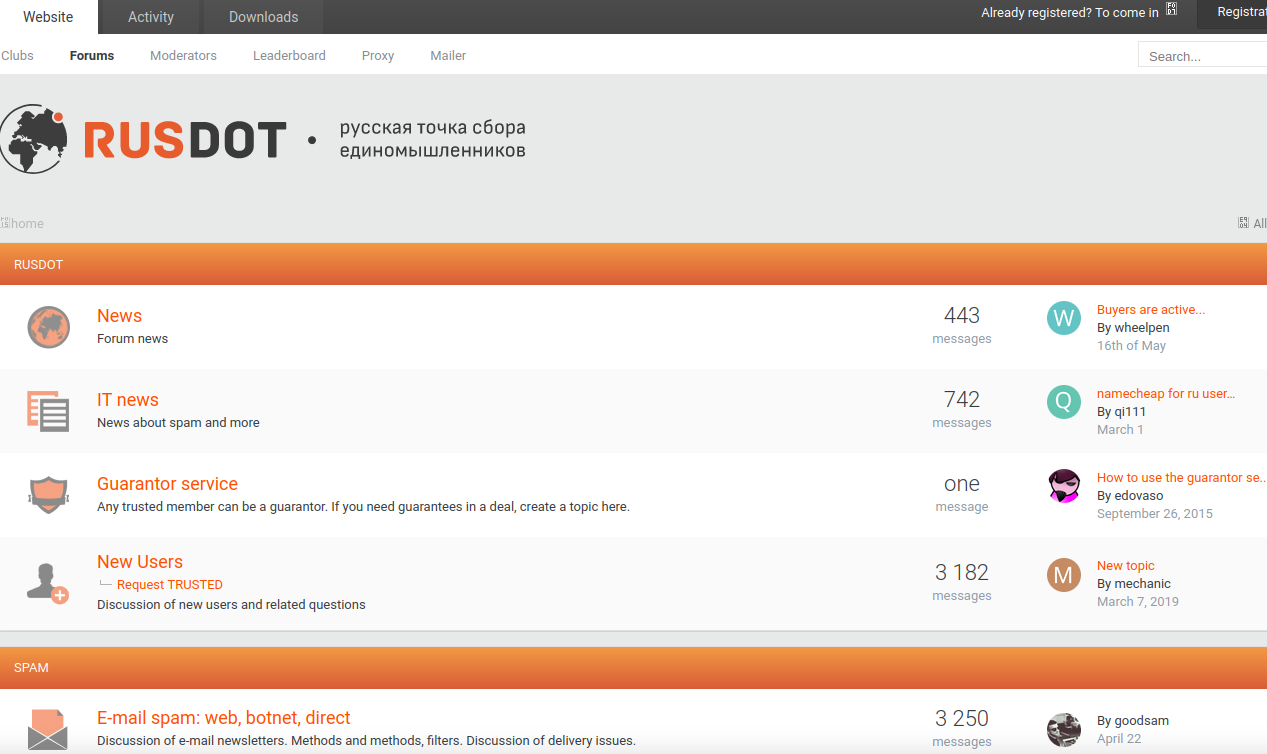
A Google-translated version of the Rusdot spam forum.
Despite maintaining his innocence, Kloster reportedly told the Bulgarian judge that he could be useful to American investigators.
“America is looking for me because I have enormous information and they need it,” Kloster told the court, according to 24Chasa. “That’s why they want me.”
The Bulgarian court agreed, and granted his extradition. Kloster’s fiancee also attended the extradition hearing, and reportedly wept in the hall outside the entire time.
Kloster turned 36 while awaiting his extradition hearing, and may soon be facing charges that carry punishments of up to 20 years in prison.
This month’s Patch Tuesday offers a little something for everyone, including security updates for a zero-day flaw in Microsoft Windows that is under active attack, and another Windows weakness experts say could be used to power a fast-spreading computer worm. Also, Apple has also quashed a pair of zero-day bugs affecting certain macOS and iOS users, and released iOS 16, which offers a new privacy and security feature called “Lockdown Mode.” And Adobe axed 63 vulnerabilities in a range of products.

Microsoft today released software patches to plug at least 64 security holes in Windows and related products. Worst in terms of outright scariness is CVE-2022-37969, which is a “privilege escalation” weakness in the Windows Common Log File System Driver that allows attackers to gain SYSTEM-level privileges on a vulnerable host. Microsoft says this flaw is already being exploited in the wild.
Kevin Breen, director of cyber threat research at Immersive Labs, said any vulnerability that is actively targeted by attackers in the wild must be put to the top of any patching list.
“Not to be fooled by its relatively low CVSS score of 7.8, privilege escalation vulnerabilities are often highly sought after by cyber attackers,” Breen said. “Once an attacker has managed to gain a foothold on a victim’s system, one of their first actions will be to gain a higher level of permissions, allowing the attacker to disable security applications and any device monitoring. There is no known workaround to date, so patching is the only effective mitigation.”
Satnam Narang at Tenable said CVE-2022-24521 — a similar vulnerability in the same Windows log file component — was patched earlier this year as part of Microsoft’s April Patch Tuesday release and was also exploited in the wild.
“CVE-2022-37969 was disclosed by several groups, though it’s unclear if CVE-2022-37969 is a patch-bypass for CVE-2022-24521 at this point,” Narang said.
Another vulnerability Microsoft patched this month — CVE-2022-35803 — also seems to be related to the same Windows log file component. While there are no indications CVE-2022-35803 is being actively exploited, Microsoft suggests that exploitation of this flaw is more likely than not.
Trend Micro’s Dustin Childs called attention to CVE-2022-34718, a remote code execution flaw in the Windows TCP/IP service that could allow an unauthenticated attacker to execute code with elevated privileges on affected systems without user interaction.
“That officially puts it into the ‘wormable’ category and earns it a CVSS rating of 9.8,” Childs said. “However, only systems with IPv6 enabled and IPSec configured are vulnerable. While good news for some, if you’re using IPv6 (as many are), you’re probably running IPSec as well. Definitely test and deploy this update quickly.”
Cisco Talos warns about four critical vulnerabilities fixed this month — CVE-2022-34721 and CVE-2022-34722 — which have severity scores of 9.8, though they are “less likely” to be exploited, according to Microsoft.
“These are remote code execution vulnerabilities in the Windows Internet Key Exchange protocol that could be triggered if an attacker sends a specially crafted IP packet,” wrote Jon Munshaw and Asheer Malhotra. “Two other critical vulnerabilities, CVE-2022-35805 and CVE-2022-34700 exist in on-premises instances of Microsoft Dynamics 365. An authenticated attacker could exploit these vulnerabilities to run a specially crafted trusted solution package and execute arbitrary SQL commands. The attacker could escalate their privileges further and execute commands as the database owner.”
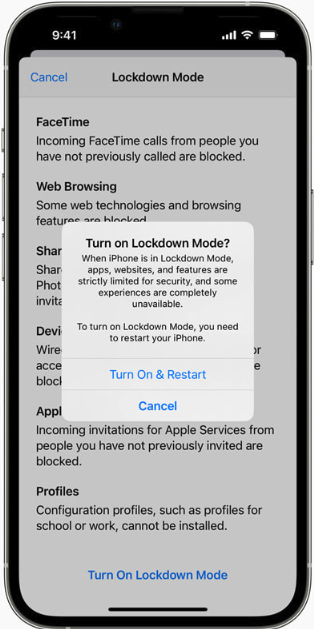 Not to be outdone, Apple fixed at least two zero-day vulnerabilities when it released updates for iOS, iPadOS, macOS and Safari. CVE-2022-32984 is a problem in the deepest recesses of the operating system (the kernel). Apple pushed an emergency update for a related zero-day last month in CVE-2022-32983, which could be used to foist malware on iPhones, iPads and Macs that visited a booby-trapped website.
Not to be outdone, Apple fixed at least two zero-day vulnerabilities when it released updates for iOS, iPadOS, macOS and Safari. CVE-2022-32984 is a problem in the deepest recesses of the operating system (the kernel). Apple pushed an emergency update for a related zero-day last month in CVE-2022-32983, which could be used to foist malware on iPhones, iPads and Macs that visited a booby-trapped website.
Also listed under active attack is CVE-2022-32817, which has been fixed on macOS 12.6 (Monterey), macOS 11.7 (Big Sur), iOS 15.7 and iPadOS 15.7, and iOS 16. The same vulnerability was fixed in Apple Watch in July 2022, and credits Xinru Chi of Japanese cybersecurity firm Pangu Lab.
“Interestingly, this CVE is also listed in the advisory for iOS 16, but it is not called out as being under active exploit for that flavor of the OS,” Trend Micro’s Childs noted. “Apple does state in its iOS 16 advisory that ‘Additional CVE entries to be added soon.’ It’s possible other bugs could also impact this version of the OS. Either way, it’s time to update your Apple devices.”
Apple’s iOS 16 includes two new security and privacy features — Lockdown Mode and Safety Check. Wired.com describes Safety Check as a feature for users who are at risk for, or currently experiencing, domestic abuse.
“The tool centralizes a number of controls in one place to make it easier for users to manage and revoke access to their location data and reset privacy-related permissions,” wrote Lily Hay Newman.
“Lockdown Mode, on the other hand, is meant for users who potentially face targeted spyware attacks and aggressive state-backed hacking. The feature comprehensively restricts any nonessential iOS features so there are as few potential points of entry to a device as possible. As more governments and repressive entities around the world have begun purchasing powerful commodity spyware to target individuals of particular importance or interest, iOS’s general security defenses haven’t been able to keep pace with these specialized threats.”
To turn on Lockdown Mode in iOS 16, go to Settings, then Privacy and Security, then Lockdown Mode. Safety Check is located in the same area.
Finally, Adobe released seven patches addressing 63 security holes in Adobe Experience Manager, Bridge, InDesign, Photoshop, InCopy, Animate, and Illustrator. More on those updates is here.
Don’t forget to back up your data and/or system before applying any security updates. If you experience glitches or problems installing any of these patches this month, please consider leaving a comment about it below; there’s a decent chance other readers have experienced the same and may chime in here with useful tips.
Phishers are enjoying remarkable success using text messages to steal remote access credentials and one-time passcodes from employees at some of the world’s largest technology companies and customer support firms. A recent spate of SMS phishing attacks from one cybercriminal group has spawned a flurry of breach disclosures from affected companies, which are all struggling to combat the same lingering security threat: The ability of scammers to interact directly with employees through their mobile devices.

In mid-June 2022, a flood of SMS phishing messages began targeting employees at commercial staffing firms that provide customer support and outsourcing to thousands of companies. The missives asked users to click a link and log in at a phishing page that mimicked their employer’s Okta authentication page. Those who submitted credentials were then prompted to provide the one-time password needed for multi-factor authentication.
The phishers behind this scheme used newly-registered domains that often included the name of the target company, and sent text messages urging employees to click on links to these domains to view information about a pending change in their work schedule.
The phishing sites leveraged a Telegram instant message bot to forward any submitted credentials in real-time, allowing the attackers to use the phished username, password and one-time code to log in as that employee at the real employer website. But because of the way the bot was configured, it was possible for security researchers to capture the information being sent by victims to the public Telegram server.
This data trove was first reported by security researchers at Singapore-based Group-IB, which dubbed the campaign “0ktapus” for the attackers targeting organizations using identity management tools from Okta.com.
“This case is of interest because despite using low-skill methods it was able to compromise a large number of well-known organizations,” Group-IB wrote. “Furthermore, once the attackers compromised an organization they were quickly able to pivot and launch subsequent supply chain attacks, indicating that the attack was planned carefully in advance.”
It’s not clear how many of these phishing text messages were sent out, but the Telegram bot data reviewed by KrebsOnSecurity shows they generated nearly 10,000 replies over approximately two months of sporadic SMS phishing attacks targeting more than a hundred companies.
A great many responses came from those who were apparently wise to the scheme, as evidenced by the hundreds of hostile replies that included profanity or insults aimed at the phishers: The very first reply recorded in the Telegram bot data came from one such employee, who responded with the username “havefuninjail.”
Still, thousands replied with what appear to be legitimate credentials — many of them including one-time codes needed for multi-factor authentication. On July 20, the attackers turned their sights on internet infrastructure giant Cloudflare.com, and the intercepted credentials show at least three employees fell for the scam.
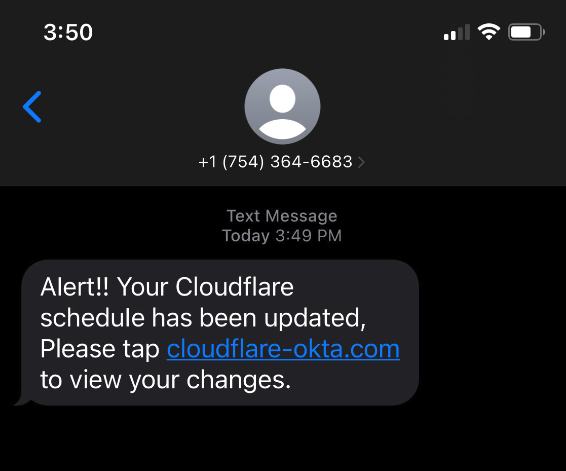
Image: Cloudflare.com
In a blog post earlier this month, Cloudflare said it detected the account takeovers and that no Cloudflare systems were compromised. Cloudflare said it does not rely on one-time passcodes as a second factor, so there was nothing to provide to the attackers. But Cloudflare said it wanted to call attention to the phishing attacks because they would probably work against most other companies.
“This was a sophisticated attack targeting employees and systems in such a way that we believe most organizations would be likely to be breached,” Cloudflare CEO Matthew Prince wrote. “On July 20, 2022, the Cloudflare Security team received reports of employees receiving legitimate-looking text messages pointing to what appeared to be a Cloudflare Okta login page. The messages began at 2022-07-20 22:50 UTC. Over the course of less than 1 minute, at least 76 employees received text messages on their personal and work phones. Some messages were also sent to the employees family members.”
On three separate occasions, the phishers targeted employees at Twilio.com, a San Francisco based company that provides services for making and receiving text messages and phone calls. It’s unclear how many Twilio employees received the SMS phishes, but the data suggest at least four Twilio employees responded to a spate of SMS phishing attempts on July 27, Aug. 2, and Aug. 7.
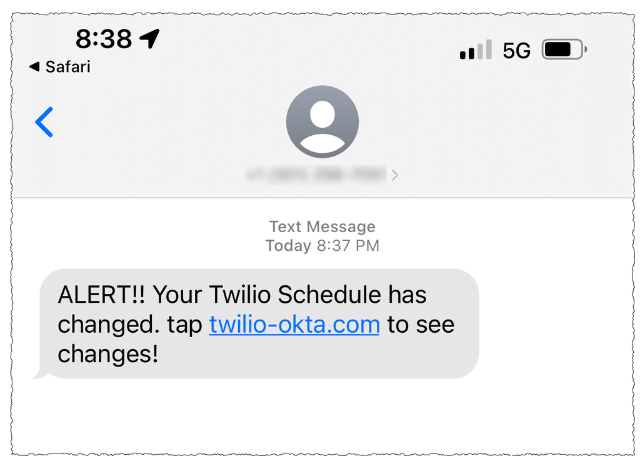
On that last date, Twilio disclosed that on Aug. 4 it became aware of unauthorized access to information related to a limited number of Twilio customer accounts through a sophisticated social engineering attack designed to steal employee credentials.
“This broad based attack against our employee base succeeded in fooling some employees into providing their credentials,” Twilio said. “The attackers then used the stolen credentials to gain access to some of our internal systems, where they were able to access certain customer data.”
That “certain customer data” included information on roughly 1,900 users of the secure messaging app Signal, which relied on Twilio to provide phone number verification services. In its disclosure on the incident, Signal said that with their access to Twilio’s internal tools the attackers were able to re-register those users’ phone numbers to another device.
On Aug. 25, food delivery service DoorDash disclosed that a “sophisticated phishing attack” on a third-party vendor allowed attackers to gain access to some of DoorDash’s internal company tools. DoorDash said intruders stole information on a “small percentage” of users that have since been notified. TechCrunch reported last week that the incident was linked to the same phishing campaign that targeted Twilio.
This phishing gang apparently had great success targeting employees of all the major mobile wireless providers, but most especially T-Mobile. Between July 10 and July 16, dozens of T-Mobile employees fell for the phishing messages and provided their remote access credentials.
“Credential theft continues to be an ongoing issue in our industry as wireless providers are constantly battling bad actors that are focused on finding new ways to pursue illegal activities like this,” T-Mobile said in a statement. “Our tools and teams worked as designed to quickly identify and respond to this large-scale smishing attack earlier this year that targeted many companies. We continue to work to prevent these types of attacks and will continue to evolve and improve our approach.”
This same group saw hundreds of responses from employees at some of the largest customer support and staffing firms, including Teleperformanceusa.com, Sitel.com and Sykes.com. Teleperformance did not respond to requests for comment. KrebsOnSecurity did hear from Christopher Knauer, global chief security officer at Sitel Group, the customer support giant that recently acquired Sykes. Knauer said the attacks leveraged newly-registered domains and asked employees to approve upcoming changes to their work schedules.
Knauer said the attackers set up the phishing domains just minutes in advance of spamming links to those domains in phony SMS alerts to targeted employees. He said such tactics largely sidestep automated alerts generated by companies that monitor brand names for signs of new phishing domains being registered.
“They were using the domains as soon as they became available,” Knauer said. “The alerting services don’t often let you know until 24 hours after a domain has been registered.”
On July 28 and again on Aug. 7, several employees at email delivery firm Mailchimp provided their remote access credentials to this phishing group. According to an Aug. 12 blog post, the attackers used their access to Mailchimp employee accounts to steal data from 214 customers involved in cryptocurrency and finance.
On Aug. 15, the hosting company DigitalOcean published a blog post saying it had severed ties with MailChimp after its Mailchimp account was compromised. DigitalOcean said the MailChimp incident resulted in a “very small number” of DigitalOcean customers experiencing attempted compromises of their accounts through password resets.
According to interviews with multiple companies hit by the group, the attackers are mostly interested in stealing access to cryptocurrency, and to companies that manage communications with people interested in cryptocurrency investing. In an Aug. 3 blog post from email and SMS marketing firm Klaviyo.com, the company’s CEO recounted how the phishers gained access to the company’s internal tools, and used that to download information on 38 crypto-related accounts.
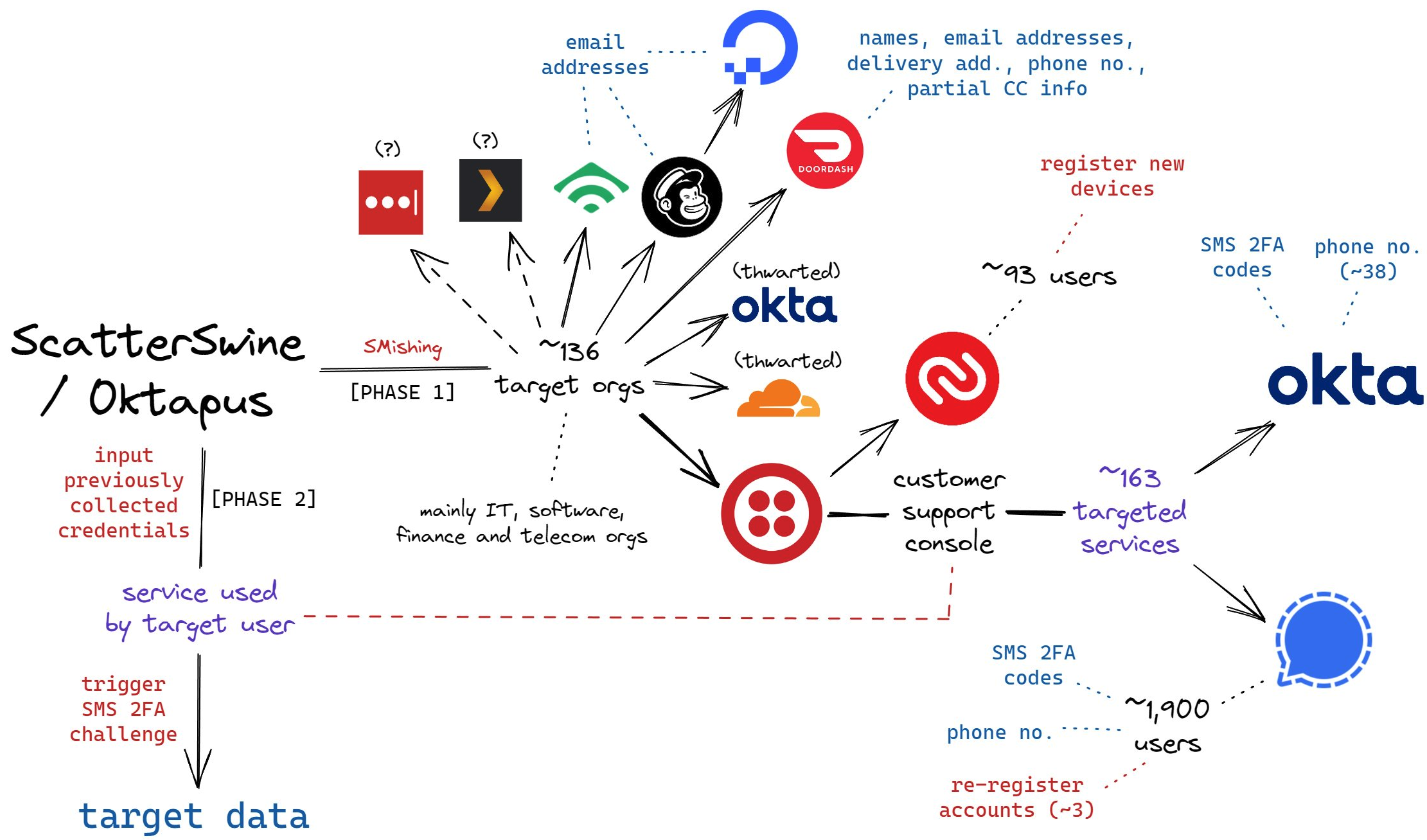
A flow chart of the attacks by the SMS phishing group known as 0ktapus and ScatterSwine. Image: Amitai Cohen for Wiz.io. twitter.com/amitaico.
The ubiquity of mobile phones became a lifeline for many companies trying to manage their remote employees throughout the Coronavirus pandemic. But these same mobile devices are fast becoming a liability for organizations that use them for phishable forms of multi-factor authentication, such as one-time codes generated by a mobile app or delivered via SMS.
Because as we can see from the success of this phishing group, this type of data extraction is now being massively automated, and employee authentication compromises can quickly lead to security and privacy risks for the employer’s partners or for anyone in their supply chain.
Unfortunately, a great many companies still rely on SMS for employee multi-factor authentication. According to a report this year from Okta, 47 percent of workforce customers deploy SMS and voice factors for multi-factor authentication. That’s down from 53 percent that did so in 2018, Okta found.
Some companies (like Knauer’s Sitel) have taken to requiring that all remote access to internal networks be managed through work-issued laptops and/or mobile devices, which are loaded with custom profiles that can’t be accessed through other devices.
Others are moving away from SMS and one-time code apps and toward requiring employees to use physical FIDO multi-factor authentication devices such as security keys, which can neutralize phishing attacks because any stolen credentials can’t be used unless the phishers also have physical access to the user’s security key or mobile device.
This came in handy for Twitter, which announced last year that it was moving all of its employees to using security keys, and/or biometric authentication via their mobile device. The phishers’ Telegram bot reported that on June 16, 2022, five employees at Twitter gave away their work credentials. In response to questions from KrebsOnSecurity, Twitter confirmed several employees were relieved of their employee usernames and passwords, but that its security key requirement prevented the phishers from abusing that information.
Twitter accelerated its plans to improve employee authentication following the July 2020 security incident, wherein several employees were phished and relieved of credentials for Twitter’s internal tools. In that intrusion, the attackers used Twitter’s tools to hijack accounts for some of the world’s most recognizable public figures, executives and celebrities — forcing those accounts to tweet out links to bitcoin scams.
“Security keys can differentiate legitimate sites from malicious ones and block phishing attempts that SMS 2FA or one-time password (OTP) verification codes would not,” Twitter said in an Oct. 2021 post about the change. “To deploy security keys internally at Twitter, we migrated from a variety of phishable 2FA methods to using security keys as our only supported 2FA method on internal systems.”
Update, 6:02 p.m. ET: Clarified that Cloudflare does not rely on TOTP (one-time multi-factor authentication codes) as a second factor for employee authentication.
Scammers are using invoices sent through PayPal.com to trick recipients into calling a number to dispute a pending charge. The missives — which come from Paypal.com and include a link at Paypal.com that displays an invoice for the supposed transaction — state that the user’s account is about to be charged hundreds of dollars. Recipients who call the supplied toll-free number to contest the transaction are soon asked to download software that lets the scammers assume remote control over their computer.
KrebsOnSecurity recently heard from a reader who received an email from paypal.com that he immediately suspected was phony. The message’s subject read, “Billing Department of PayPal updated your invoice.”
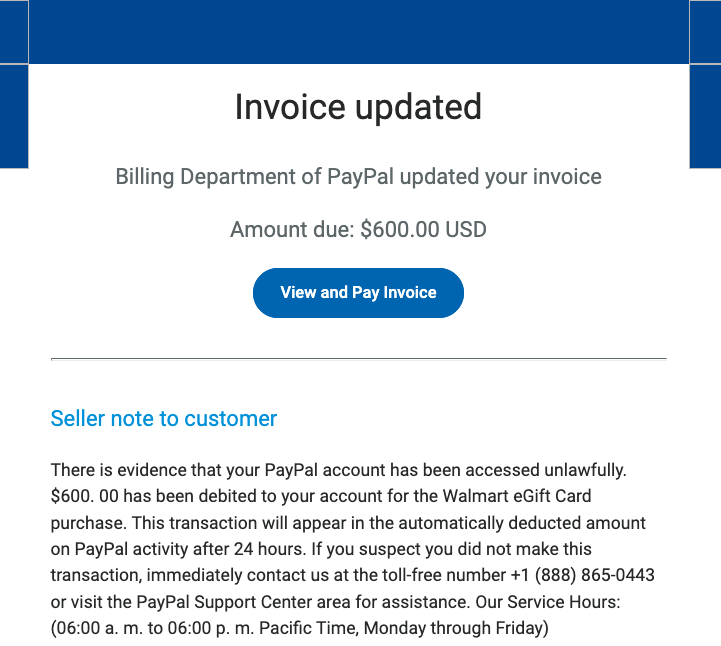
A copy of the phishing message included in the PayPal.com invoice.
While the phishing message attached to the invoice is somewhat awkwardly worded, there are many convincing aspects of this hybrid scam. For starters, all of the links in the email lead to paypal.com. Hovering over the “View and Pay Invoice” button shows the button indeed wants to load a link at paypal.com, and clicking that link indeed brings up an active invoice at paypal.com.
Also, the email headers in the phishing message (PDF) show that it passed all email validation checks as being sent by PayPal, and that it was sent through an Internet address assigned to PayPal.
Both the email and the invoice state that “there is evidence that your PayPal account has been accessed unlawfully.” The message continues:
“$600.00 has been debited to your account for the Walmart Gift Card purchase. This transaction will appear in the automatically deducted amount on PayPal activity after 24 hours. If you suspect you did not make this transaction, immediately contact us at the toll-free number….”
Here’s the invoice that popped up when the “View and Pay Invoice” button was clicked:
The reader who shared this phishing email said he logged into his PayPal account and could find no signs of the invoice in question. A call to the toll-free number listed in the invoice was received by a man who answered the phone as generic “customer service,” instead of trying to spoof PayPal or Walmart. Very quickly into the conversation he suggested visiting a site called globalquicksupport[.]com to download a remote administration tool. It was clear then where the rest of this call was going.
I can see this scam tricking a great many people, especially since both the email and invoice are sent through PayPal’s systems — which practically guarantees that the message will be successfully delivered. The invoices appear to have been sent from a compromised or fraudulent PayPal Business account, which allows users to send invoices like the one shown above. Details of this scam were shared Wednesday with PayPal’s anti-abuse (phishing@paypal.com) and media relations teams.
PayPal said in a written statement that phishing attempts are common and can take many forms.
“We have a zero-tolerance policy on our platform for attempted fraudulent activity, and our teams work tirelessly to protect our customers,” PayPal said. “We are aware of this well-known phishing scam and have put additional controls in place to mitigate this specific incident. Nonetheless, we encourage customers to always be vigilant online and to contact Customer Service directly if they suspect they are a target of a scam.”
It’s remarkable how well today’s fraudsters have adapted to hijacking the very same tools that financial institutions have long used to make their customers feel safe transacting online. It’s no accident that one of the most prolific scams going right now — the Zelle Fraud Scam — starts with a text message about an unauthorized payment that appears to come from your bank. After all, financial institutions have spent years encouraging customers to sign up for mobile alerts via SMS about suspicious transactions, and to expect the occasional inbound call about possibly fraudulent transactions.
Also, today’s scammers are less interested in stealing your PayPal login than they are in phishing your entire computer and online life with remote administration software, which seems to be the whole point of so many scams these days. Because why rob just one online account when you can plunder them all?
The best advice to sidestep phishing scams is to avoid clicking on links that arrive unbidden in emails, text messages and other mediums. Most phishing scams invoke a temporal element that warns of dire consequences should you fail to respond or act quickly. If you’re unsure whether the message is legitimate, take a deep breath and visit the site or service in question manually — ideally, using a browser bookmark to avoid potential typosquatting sites.

Image: Shutterstock.
A cybersecurity firm says it has intercepted a large, unique stolen data set containing the names, addresses, email addresses, phone numbers, Social Security Numbers and dates of birth on nearly 23 million Americans. The firm’s analysis of the data suggests it corresponds to current and former customers of AT&T. The telecommunications giant stopped short of saying the data wasn’t theirs, but it maintains the records do not appear to have come from its systems and may be tied to a previous data incident at another company.
Milwaukee-based cybersecurity consultancy Hold Security said it intercepted a 1.6 gigabyte compressed file on a popular dark web file-sharing site. The largest item in the archive is a 3.6 gigabyte file called “dbfull,” and it contains 28.5 million records, including 22.8 million unique email addresses and 23 million unique SSNs. There are no passwords in the database.
Hold Security founder Alex Holden said a number of patterns in the data suggest it relates to AT&T customers. For starters, email addresses ending in “att.net” accounted for 13.7 percent of all addresses in the database, with addresses from SBCGLobal.net and Bellsouth.net — both AT&T companies — making up another seven percent. In contrast, Gmail users made up more than 30 percent of the data set, with Yahoo addresses accounting for 24 percent. More than 10,000 entries in the database list “none@att.com” in the email field.
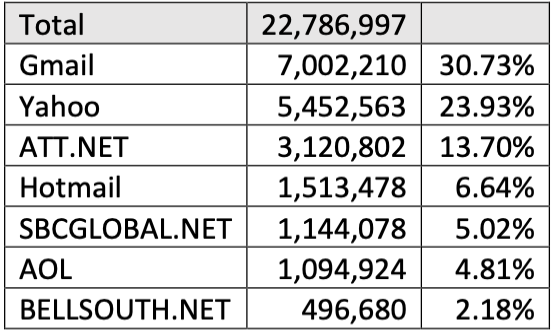
Hold Security found these email domains account for 87% of all domains in the data set. Nearly 21% belonged to AT&T customers.
Holden’s team also examined the number of email records that included an alias in the username portion of the email, and found 293 email addresses with plus addressing. Of those, 232 included an alias that indicated the customer had signed up at some AT&T property; 190 of the aliased email addresses were “+att@”; 42 were “+uverse@,” an oddly specific reference to an AT&T entity that included broadband Internet. In September 2016, AT&T rebranded U-verse as AT&T Internet.
According to its website, AT&T Internet is offered in 21 states, including Alabama, Arkansas, California, Florida, Georgia, Indiana, Kansas, Kentucky, Louisiana, Michigan, Missouri, Nevada, North Carolina, Ohio, Oklahoma, Tennessee, Texas and Wisconsin. Nearly all of the records in the database that contain a state designation corresponded to those 21 states; all other states made up just 1.64 percent of the records, Hold Security found.
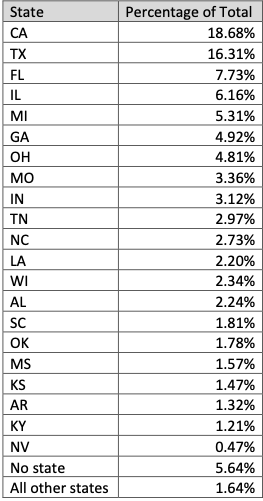
Image: Hold Security.
The vast majority of records in this database belong to consumers, but almost 13,000 of the entries are for corporate entities. Holden said 387 of those corporate names started with “ATT,” with various entries like “ATT PVT XLOW” appearing 81 times. And most of the addresses for these entities are AT&T corporate offices.
How old is this data? One clue may be in the dates of birth exposed in this database. There are very few records in this file with dates of birth after 2000.
“Based on these statistics, we see that the last significant number of subscribers born in March of 2000,” Holden told KrebsOnSecurity, noting that AT&T requires new account holders to be 18 years of age or older. “Therefore, it makes sense that the dataset was likely created close to March of 2018.”
There was also this anomaly: Holden said one of his analysts is an AT&T customer with a 13-letter last name, and that her AT&T bill has always had the same unique misspelling of her surname (they added yet another letter). He said the analyst’s name is identically misspelled in this database.
KrebsOnSecurity shared the large data set with AT&T, as well as Hold Security’s analysis of it. AT&T ultimately declined to say whether all of the people in the database are or were at some point AT&T customers. The company said the data appears to be several years old, and that “it’s not immediately possible to determine the percentage that may be customers.”
“This information does not appear to have come from our systems,” AT&T said in a written statement. “It may be tied to a previous data incident at another company. It is unfortunate that data can continue to surface over several years on the dark web. However, customers often receive notices after such incidents, and advice for ID theft is consistent and can be found online.”
The company declined to elaborate on what they meant by “a previous data incident at another company.”
But it seems likely that this database is related to one that went up for sale on a hacker forum on August 19, 2021. That auction ran with the title “AT&T Database +70M (SSN/DOB),” and was offered by ShinyHunters, a well-known threat actor with a long history of compromising websites and developer repositories to steal credentials or API keys.
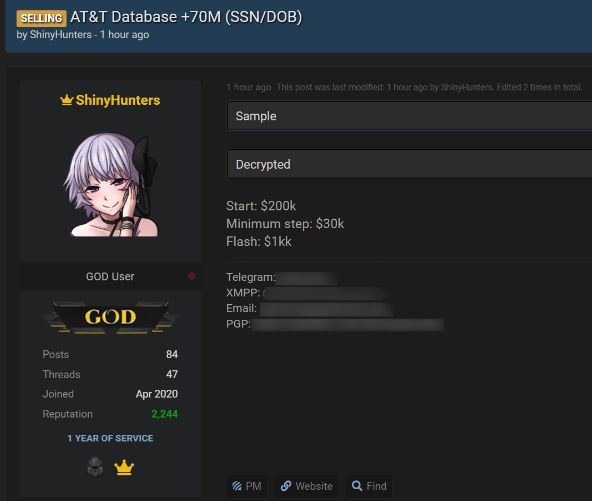
Image: BleepingComputer
ShinyHunters established the starting price for the auction at $200,000, but set the “flash” or “buy it now” price at $1 million. The auction also included a small sampling of the stolen information, but that sample is no longer available. The hacker forum where the ShinyHunters sales thread existed was seized by the FBI in April, and its alleged administrator arrested.
But cached copies of the auction, as recorded by cyber intelligence firm Intel 471, show ShinyHunters received bids of up to $230,000 for the entire database before they suspended the sale.
“This thread has been deleted several times,” ShinyHunters wrote in their auction discussion on Sept. 6, 2021. “Therefore, the auction is suspended. AT&T will be available on WHM as soon as they accept new vendors.”
The WHM initialism was a reference to the White House Market, a dark web marketplace that shut down in October 2021.
“In many cases, when a database is not sold, ShinyHunters will release it for free on hacker forums,” wrote BleepingComputer’s Lawrence Abrams, who broke the news of the auction last year and confronted AT&T about the hackers’ claims.
AT&T gave Abrams a similar statement, saying the data didn’t come from their systems.
“When asked whether the data may have come from a third-party partner, AT&T chose not to speculate,” Abrams wrote. “‘Given this information did not come from us, we can’t speculate on where it came from or whether it is valid,'” AT&T told BleepingComputer.
Asked to respond to AT&T’s denial, ShinyHunters told BleepingComputer at the time, “I don’t care if they don’t admit. I’m just selling.”
On June 1, 2022, a 21-year-old Frenchman was arrested in Morocco for allegedly being a member of ShinyHunters. Databreaches.net reports the defendant was arrested on an Interpol “Red Notice” at the request of a U.S. federal prosecutor from Washington state.
Databreaches.net suggests the warrant could be tied to a ShinyHunters theft in May 2020, when the group announced they had exfiltrated 500 GB of Microsoft’s source code from Microsoft’s private GitHub repositories.
“Researchers assess that Shiny Hunters gained access to roughly 1,200 private repositories around March 28, 2020, which have since been secured,” reads a May 2020 alert posted by the New Jersey Cybersecurity & Communications Integration Cell, a component within the New Jersey Office of Homeland Security and Preparedness.
“Though the breach was largely dismissed as insignificant, some images of the directory listing appear to contain source code for Azure, Office, and some Windows runtimes, and concerns have been raised regarding access to private API keys or passwords that may have been mistakenly included in some private repositories,” the alert continues. “Additionally, Shiny Hunters is flooding dark web marketplaces with breached databases.”
Last month, T-Mobile agreed to pay $350 million to settle a consolidated class action lawsuit over a breach in 2021 that affected 40 million current and former customers. The breach came to light on Aug. 16, 2021, when someone starting selling tens of millions of SSN/DOB records from T-Mobile on the same hacker forum where the ShinyHunters would post their auction for the claimed AT&T database just three days later.
T-Mobile has not disclosed many details about the “how” of last year’s breach, but it said the intruder(s) “leveraged their knowledge of technical systems, along with specialized tools and capabilities, to gain access to our testing environments and then used brute force attacks and other methods to make their way into other IT servers that included customer data.”
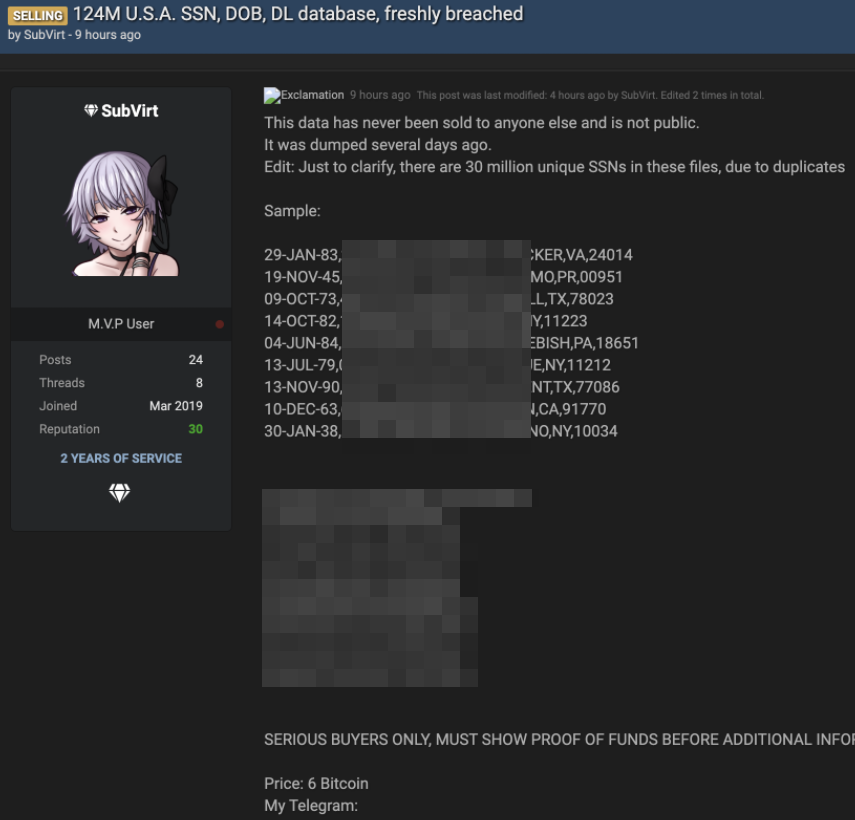
A sales thread tied to the stolen T-Mobile customer data.
Microsoft today released updates to fix a record 141 security vulnerabilities in its Windows operating systems and related software. Once again, Microsoft is patching a zero-day vulnerability in the Microsoft Support Diagnostics Tool (MSDT), a service built into Windows. Redmond also addressed multiple flaws in Exchange Server — including one that was disclosed publicly prior to today — and it is urging organizations that use Exchange for email to update as soon as possible and to enable additional protections.

In June, Microsoft patched a vulnerability in MSDT dubbed “Follina” that had been used in active attacks for at least three months prior. This latest MSDT bug — CVE-2022-34713 — is a remote code execution flaw that requires convincing a target to open a booby-trapped file, such as an Office document. Microsoft this month also issued a different patch for another MSDT flaw, tagged as CVE-2022-35743.
The publicly disclosed Exchange flaw is CVE-2022-30134, which is an information disclosure weakness. Microsoft also released fixes for three other Exchange flaws that rated a “critical” label, meaning they could be exploited remotely to compromise the system and with no help from users. Microsoft says addressing some of the Exchange vulnerabilities fixed this month requires administrators to enable Windows Extended protection on Exchange Servers. See Microsoft’s blog post on the Exchange Server updates for more details.
“If your organization runs local exchange servers, this trio of CVEs warrant an urgent patch,” said Kevin Breen, director of cyber threat research for Immerse Labs. “Exchanges can be treasure troves of information, making them valuable targets for attackers. With CVE-2022-24477, for example, an attacker can gain initial access to a user’s host and could take over the mailboxes for all exchange users, sending and reading emails and documents. For attackers focused on Business Email Compromise this kind of vulnerability can be extremely damaging.”
The other two critical Exchange bugs are tracked as CVE-2022-24516 and CVE-2022-21980. It’s difficult to believe it’s only been a little more than a year since malicious hackers worldwide pounced in a bevy of zero-day Exchange vulnerabilities to remotely compromise the email systems for hundreds of thousands of organizations running Exchange Server locally for email. That lingering catastrophe is reminder enough that critical Exchange bugs deserve immediate attention.
The SANS Internet Storm Center‘s rundown on Patch Tuesday warns that a critical remote code execution bug in the Windows Point-to-Point Protocol (CVE-2022-30133) could become “wormable” — a threat capable of spreading across a network without any user interaction.
“Another critical vulnerability worth mentioning is an elevation of privilege affecting Active Directory Domain Services (CVE-2022-34691),” SANS wrote. “According to the advisory, ‘An authenticated user could manipulate attributes on computer accounts they own or manage, and acquire a certificate from Active Directory Certificate Services that would allow elevation of privilege to System.’ A system is vulnerable only if Active Directory Certificate Services is running on the domain. The CVSS for this vulnerability is 8.8.”
Breen highlighted a set of four vulnerabilities in Visual Studio that earned Microsoft’s less-dire “important” rating but that nevertheless could be vitally important for the security of developer systems.
“Developers are empowered with access to API keys and deployment pipelines that, if compromised, could be significantly damaging to organizations,” he said. “So it’s no surprise they are often targeted by more advanced attackers. Patches for their tools should not be overlooked. We’re seeing a continued trend of supply-chain compromise too, making it vital that we ensure developers, and their tools, are kept up-to-date with the same rigor we apply to standard updates.”
Greg Wiseman, product manager at Rapid7, pointed to an interesting bug Microsoft patched in Windows Hello, the biometric authentication mechanism for Windows 10. Microsoft notes that the successful exploitation of the weakness requires physical access to the target device, but would allow an attacker to bypass a facial recognition check.
Wiseman said despite the record number of vulnerability fixes from Redmond this month, the numbers are slightly less dire.
“20 CVEs affect their Chromium-based Edge browser and 34 affect Azure Site Recovery (up from 32 CVEs affecting that product last month),” Wiseman wrote. “As usual, OS-level updates will address a lot of these, but note that some extra configuration is required to fully protect Exchange Server this month.”
As it often does on Patch Tuesday, Adobe has also released security updates for many of its products, including Acrobat and Reader, Adobe Commerce and Magento Open Source. More details here.
Please consider backing up your system or at least your important documents and data before applying system updates. And if you run into any problems with these updates, please drop a note about it here in the comments.

The 911 service as it existed until July 28, 2022.
911[.]re, a proxy service that since 2015 has sold access to hundreds of thousands of Microsoft Windows computers daily, announced this week that it is shutting down in the wake of a data breach that destroyed key components of its business operations. The abrupt closure comes ten days after KrebsOnSecurity published an in-depth look at 911 and its connections to shady pay-per-install affiliate programs that secretly bundled 911’s proxy software with other titles, including “free” utilities and pirated software.
911[.]re is was one of the original “residential proxy” networks, which allow someone to rent a residential IP address to use as a relay for his/her Internet communications, providing anonymity and the advantage of being perceived as a residential user surfing the web.
Residential proxy services are often marketed to people seeking the ability to evade country-specific blocking by the major movie and media streaming providers. But some of them — like 911 — build their networks in part by offering “free VPN” or “free proxy” services that are powered by software which turns the user’s PC into a traffic relay for other users. In this scenario, users indeed get to use a free VPN service, but they are often unaware that doing so will turn their computer into a proxy that lets others use their Internet address to transact online.
From a website’s perspective, the IP traffic of a residential proxy network user appears to originate from the rented residential IP address, not from the proxy service customer. These services can be used in a legitimate manner for several business purposes — such as price comparisons or sales intelligence — but they are massively abused for hiding cybercrime activity because they can make it difficult to trace malicious traffic to its original source.
As noted in KrebsOnSecurity’s July 19 story on 911, the proxy service operated multiple pay-per-install schemes that paid affiliates to surreptitiously bundle the proxy software with other software, continuously generating a steady stream of new proxies for the service.

A cached copy of flashupdate[.]net circa 2016, which shows it was the homepage of a pay-per-install affiliate program that incentivized the silent installation of 911’s proxy software.
Within hours of that story, 911 posted a notice at the top of its site, saying, “We are reviewing our network and adding a series of security measures to prevent misuse of our services. Proxy balance top-up and new user registration are closed. We are reviewing every existing user, to ensure their usage is legit and [in] compliance with our Terms of Service.”
At this announcement, all hell broke loose on various cybercrime forums, where many longtime 911 customers reported they were unable to use the service. Others affected by the outage said it seemed 911 was trying to implement some sort of “know your customer” rules — that maybe 911 was just trying to weed out those customers using the service for high volumes of cybercriminal activity.
Then on July 28, the 911 website began redirecting to a notice saying, “We regret to inform you that we permanently shut down 911 and all its services on July 28th.”
According to 911, the service was hacked in early July, and it was discovered that someone manipulated the balances of a large number of user accounts. 911 said the intruders abused an application programming interface (API) that handles the topping up of accounts when users make financial deposits with the service.
“Not sure how did the hacker get in,” the 911 message reads. “Therefore, we urgently shut down the recharge system, new user registration, and an investigation started.”
However the intruders got in, 911 said, they managed to also overwrite critical 911[.]re servers, data and backups of that data.
“On July 28th, a large number of users reported that they could not log in the system,” the statement continues. “We found that the data on the server was maliciously damaged by the hacker, resulting in the loss of data and backups. Its [sic] confirmed that the recharge system was also hacked the same way. We were forced to make this difficult decision due to the loss of important data that made the service unrecoverable.”
Operated largely out of China, 911 was an enormously popular service across many cybercrime forums, and it became something akin to critical infrastructure for this community after two of 911’s longtime competitors — malware-based proxy services VIP72 and LuxSocks — closed their doors in the past year.
Now, many on the crime forums who relied on 911 for their operations are wondering aloud whether there are any alternatives that match the scale and utility that 911 offered. The consensus seems to be a resounding “no.”
I’m guessing we may soon learn more about the security incidents that caused 911 to implode. And perhaps other proxy services will spring up to meet what appears to be a burgeoning demand for such services at the moment, with comparatively little supply.
In the meantime, 911’s absence may coincide with a measurable (if only short-lived) reprieve in unwanted traffic to top Internet destinations, including banks, retailers and cryptocurrency platforms, as many former customers of the proxy service scramble to make alternative arrangements.
Riley Kilmer, co-founder of the proxy-tracking service Spur.us, said 911’s network will be difficult to replicate in the short run.
“My speculation is [911’s remaining competitors] are going to get a major boost in the short term, but a new player will eventually come along,” Kilmer said. “None of those are good replacements for LuxSocks or 911. However, they will all allow anyone to use them. For fraud rates, the attempts will continue but through these replacement services which should be easier to monitor and stop. 911 had some very clean IP addresses.”
911 wasn’t the only major proxy provider disclosing a breach this week tied to unauthenticated APIs: On July 28, KrebsOnSecurity reported that internal APIs exposed to the web had leaked the customer database for Microleaves, a proxy service that rotates its customers’ IP addresses every five to ten minutes. That investigation showed Microleaves — like 911 — had a long history of using pay-per-install schemes to spread its proxy software.